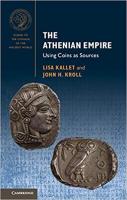
CUP (2020) p/b 202pp £17.99 (ISBN 9781107686700)
Coinage played a central role in the functioning of the Athenian empire. Minted in large part from ‘the stream of silver’ that flowed from the mines at Laurium in Attica, it fuelled the empire’s rise. In this absorbing introduction to the numismatics of the period, Kallet and Kroll show how the study of coins can supplement the literary sources and contribute significantly to our understanding of the political, social and economic history of the 5th C BC. They survey and illustrate the extraordinary variety of gold, silver, electrum and bronze coinages that were employed by Athens and other city states within the empire, and other cities and non-Greek nations that it came into contact with. My only disappointment with the book is that, for technical reasons I can understand, many of the nearly 200 coin images do not come close to the beautiful reproduction of the ‘owl’ tetradrachm on the cover.
The opening chapter begins with a succinct examination of the nature of the Athenian empire, highlighting its unprecedented dependence on a standing navy, in turn dependent on funding that had to be sustained at a very high level. This is followed by a review of the key epigraphic sources for the financial mechanisms of the empire and a discussion of the important evidence provided by coin hoards and dies that have survived to complement the individual coin record.
The first half of the second chapter weaves the histories of the silver owl and imperial Athens into a single broad narrative. Athens was one of the first Greek cities to introduce silver coins, but for 50 years these were minted on a relatively modest scale and rarely used outside Attica. However, in the last years of the 6th C a deeper and much more prolific vein of ore was discovered at Laurium and the first distinctive owls were minted. The Athenians were quick to recognise the potential benefits of high-quality coinage in external trading. It is estimated that more than 100 tonnes of it were in circulation by 480 with production accelerating towards the end of the period to fund Themistocles’ shipbuilding programme. Cruder dies are evidence of haste or the recruitment of less skilful craftsmen to increase capacity. By the middle of the century output is reckoned to have doubled and it fell away only in the closing years of the Peloponnesian War when Spartan occupation of Attica closed down mining operations. Even at the time of the city’s defeat, Athenian coinage was still a dominant currency, not only in mainland Greece and across the Aegean, but also highly valued and sought after in Egypt and much of the Near East where local currency was inadequate or non-existent. This dominance was sustained through most of the 4thC, only to be eclipsed when Alexander the Great flooded the world with his own coinage minted from the gold and silver treasures of Persia.
Further sections examine the workings of the massive silver industry, the imports and consumer culture enabled by the coinage, and the use of money by private individuals. The next section reviews the flow of owls on state business: inward as the favoured currency for the payment of tribute (other currencies were treated as bullion, which was generally valued at 95% of its weight in owls and could profitably be reminted) and outward, for the purchase of ship timber and other materials, and for the payment of crews.
The next chapter, ‘Coinages of the Allied Cities’ (from around the middle of the century, ‘the cities that Athens ruled’, more than 200 of them), surveys a large sample, demonstrating their fascinating diversity and exploring the influence of the Athenian centre on local minting and monetary policy generally.
The first half of the book lays out an extensive and detailed backdrop for the second, which comprises studies of particular developments that add factual detail to the historical record. These compact master classes in the use of coins as evidence are organised chronologically into four chapters: the pentekontaetia; the Archidamian War; 421-413 and the Peace of Nicias; and the Ionian War. They open with a section on the coinage minted by Themistocles in exile in Asia, continued by his son and perhaps his grandson, firm evidence for the authority granted him by Xerxes. A closing section describes the measures taken by Athens to replace exhausted cash reserves, first by melting down gold and silver dedications on the Acropolis (including seven hefty golden Nikes) and then, in the last desperate years of the Peloponnesian War, resorting to official, high denomination counterfeits in bronze-plated silver. In a massive irony, at about the same time, the Persians were minting their own versions of the Athenian owl, in silver and on the Attic standard, for the payment of rowers in the Peloponnesian fleet.
As the authors point out in their Preface, the study of the many coinages of 5thC Greece has been largely the preserve of specialist numismatists. In this absorbing, concise but wide-ranging introduction to the most recent scholarship, they achieve their purpose of making this important strand of evidence accessible to a wider readership of undergraduate and sixth-form students of ancient history and their teachers.
The book is one of a series of three ‘Guides to the Coinage of the Ancient World’, its companion titles The Hellenistic World and Caesar to Augustus. They are published in conjunction with the American Numismatic Society.
William Shepherd
